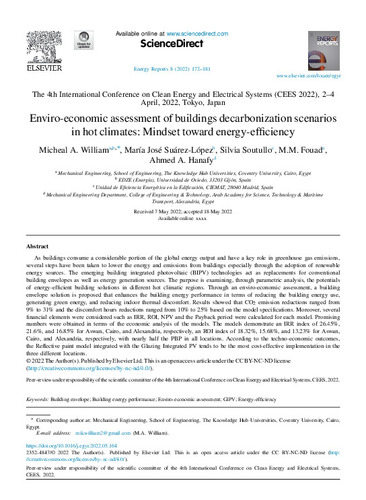Enviro-economic assessment of buildings decarbonization scenarios in hot climates: Mindset toward energy-efficiency
Autor(es) y otros:
Palabra(s) clave:
Building envelope
Building energy performance
Enviro-economic assessment
GIPV
Energy-efficiency
Fecha de publicación:
Citación:
Descripción física:
Resumen:
As buildings consume a considerable portion of the global energy output and have a key role in greenhouse gas emissions, several steps have been taken to lower the energy and emissions from buildings especially through the adoption of renewable energy sources. The emerging building integrated photovoltaic (BIPV) technologies act as replacements for conventional building envelopes as well as energy generation sources. The purpose is examining, through parametric analysis, the potentials of energy-efficient building solutions in different hot climatic regions. Through an enviro-economic assessment, a building envelope solution is proposed that enhances the building energy performance in terms of reducing the building energy use, generating green energy, and reducing indoor thermal discomfort. Results showed that CO2 emission reductions ranged from 9% to 31% and the discomfort hours reductions ranged from 10% to 25% based on the model specifications. Moreover, several financial elements were considered such as IRR, ROI, NPV and the Payback period were calculated for each model. Promising numbers were obtained in terms of the economic analysis of the models. The models demonstrate an IRR index of 26.45%, 21.6%, and 16.85% for Aswan, Cairo, and Alexandria, respectively, an ROI index of 18.32%, 15.68%, and 13.23% for Aswan, Cairo, and Alexandria, respectively, with nearly half the PBP in all locations. According to the techno-economic outcomes, the Reflective paint model integrated with the Glazing Integrated PV tends to be the most cost-effective implementation in the three different locations.
As buildings consume a considerable portion of the global energy output and have a key role in greenhouse gas emissions, several steps have been taken to lower the energy and emissions from buildings especially through the adoption of renewable energy sources. The emerging building integrated photovoltaic (BIPV) technologies act as replacements for conventional building envelopes as well as energy generation sources. The purpose is examining, through parametric analysis, the potentials of energy-efficient building solutions in different hot climatic regions. Through an enviro-economic assessment, a building envelope solution is proposed that enhances the building energy performance in terms of reducing the building energy use, generating green energy, and reducing indoor thermal discomfort. Results showed that CO2 emission reductions ranged from 9% to 31% and the discomfort hours reductions ranged from 10% to 25% based on the model specifications. Moreover, several financial elements were considered such as IRR, ROI, NPV and the Payback period were calculated for each model. Promising numbers were obtained in terms of the economic analysis of the models. The models demonstrate an IRR index of 26.45%, 21.6%, and 16.85% for Aswan, Cairo, and Alexandria, respectively, an ROI index of 18.32%, 15.68%, and 13.23% for Aswan, Cairo, and Alexandria, respectively, with nearly half the PBP in all locations. According to the techno-economic outcomes, the Reflective paint model integrated with the Glazing Integrated PV tends to be the most cost-effective implementation in the three different locations.
Descripción:
International Conference on Clean Energy and Electrical Systems (CEES 2022) (4th. 2022. Tokyo, Japan)
ISSN:
Ficheros en el ítem





